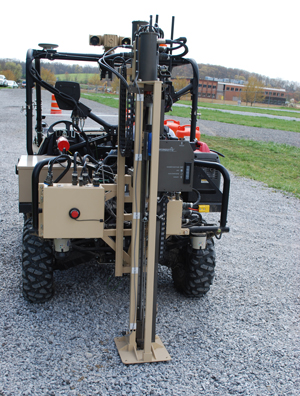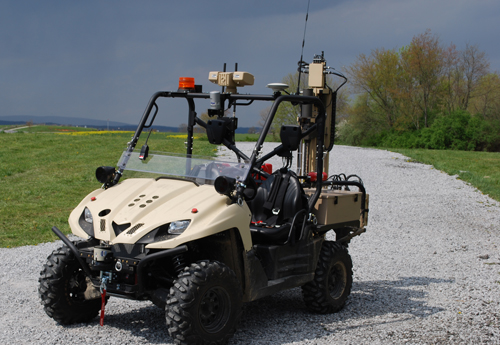TORCs unmanned ground vehicle (UGV) conversion kits, which maintain the ability for optionally manned operation, offer the proven capabilities and modularity necessary for AFRL to scale from one prototype to production quantity.
Contributed by | TORC Robotics
Air Force Research Laboratory (AFRL), headquartered at Wright-Patterson Air Force Base, Ohio, is leading the discovery, development and integration of affordable warfighting technologies for America’s forces. While AFRL largely focuses on the air, space, and cyberspace domains, they also have complex and dangerous work on the ground. One labor-intensive, high-risk mission involves performing environmental surveys to assess the viability of potential assault-zone landing strips. The extended exposure times on the open runways, with limited situational awareness, leaves the Special Tactics (ST) Surveyor Teams vulnerable to many inherent risks.
In an effort to reduce those risks and benefit from faster, more accurate data collection, AFRL sought out to develop the Robotic Assault Zone Terminal Evaluation Kit (RAZTEK), an autonomous robotic system capable of surveying expedient runways.

Realizing that the Lightweight Tactical All-Terrain Vehicle (LTATV) model used for prototype development may not be the final solution, it was critical to have a modular, platform-agnostic architecture that would allow for future RAZTEK systems to utilize a different LTATV platform with minimal reconfiguration. The robotic conversion also needed to maintain the ability for manned operation.
Solution
For the initial RAZTEK system, the customer-selected LTATV mobility platform was up-fit with TORC Robotics, LLC (TORC) technology, including:
-
ByWire Kit - for base drive-by-wire control with integrated SafeStop emergency safety systems.
"By-Wire Kit: intelligent vehicle conversion. The first step in creating an robotic vehicle is through advanced safety and computer control integration. The ByWire Kit offers complete computer control, safety, and health monitoring of essential vehicle components consisting of a clean, non-intrusive installation. The ByWire Kit provides all of these important features plus allows for further vehicle upgrades using the Tele-Op or Autonomy Kits." -
Tele-Op Kit - for remote tele-operated vehicle control and integration with the modular mission payloads.
"Tele-Op Kit: remote robotic vehicle control. The Tele-Op Kit provides all of the features of the ByWire Kit combined with wireless remote control of the vehicle. An optional video upgrade can provide real-time video feedback from cameras in order to provide heightened situational awareness to the operator. An easy-to-use operator interface provides the user with an intuitive method to control and monitor the vehicle which can be customized to fit your application." -
Autonomy Kit - for customized autonomous behaviors, including autonomous control of the Mosquito soil sampling payload.
"Autonomy Kit: scalable autonomous control. The Autonomy Kit provides all of the features of our other kits, with the addition of multiple levels of autonomous control. It can be customized to operate in a wide range of environments such as off-road terrain or urban roads, with advanced navigation features that allow for vehicle operation in GPS denied areas. Our engineers are prepared to provide a custom autonomous kit solution for your vehicle that provides task specific behaviors or work tool control."
TORC provided integration support to Tec^Edge, which installed and integrated the various kits with the MDA Corporation’s Mosquito soil sampling device.
Outcome
TORC’s unmanned ground vehicle (UGV) conversion kits, which maintain the ability for optionally manned operation, offer the proven capabilities and modularity necessary for AFRL to scale from one prototype to production quantity. Leveraging the kits allowed the focus to remain on the customized capabilities unique to the ST Survey Teams’ mission.

RAZTEK underwent two limited technical assessments with a final demonstration and delivery in May 2012.
Goal
Autonomous Vehicle for Surveying Assault-Zone Runways
-
Removes surveyors from extended exposure times with limited situational awareness
-
Automates the surveying and sample
-
Collection process for potential assault-zone landing strips
-
Enables faster, safer, and more accurate data collection with day and night operational capabilities
"I think one of the biggest enhancements is RAZTEK allows for a much faster LZ survey in addition to safety, accuracy, and reduced exposure." – Jerry Provenza, Project Manager, AFRL

The content & opinions in this article are the author’s and do not necessarily represent the views of RoboticsTomorrow
Comments (0)
This post does not have any comments. Be the first to leave a comment below.
Featured Product


